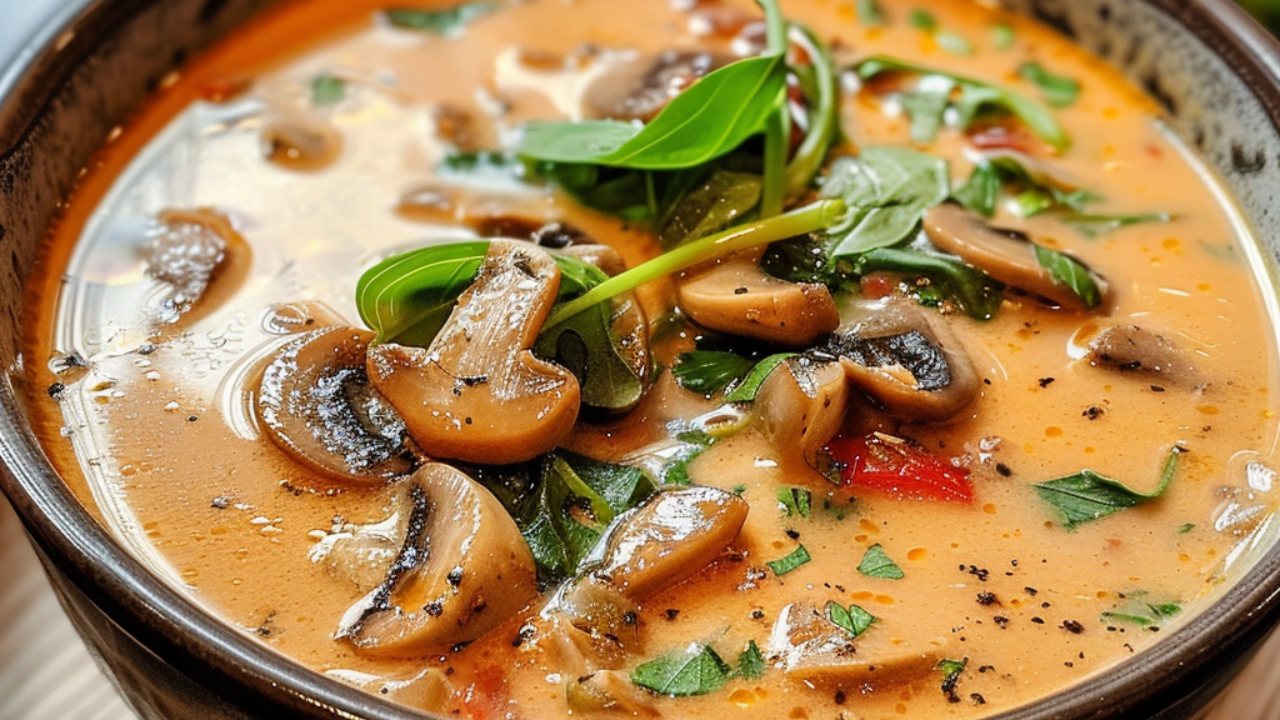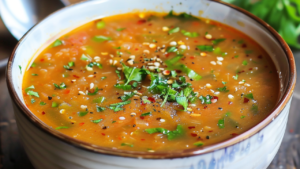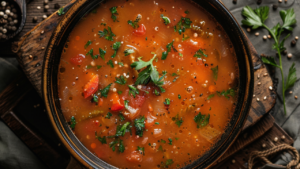What is the No 1 soup in the world? When you think about comfort food, soup often tops the list. Soups are more than just a warm bowl of goodness; they are a reflection of culture, history, and culinary mastery. But among the myriad of soups enjoyed worldwide, which one stands out as the best? This article dives deep into the world of soups, examining their history, the criteria for ranking them, and a detailed look at the top contenders. Finally, we’ll uncover why Sinigang, a Filipino soup, has been named the No 1 soup in the world. So, let’s embark on this flavorful journey together.
What is the No 1 soup in the world?
Soup, a timeless dish, holds a special place in many cultures around the globe. It’s not just about the ingredients but also about the memories and traditions associated with it. So, what makes a soup the best in the world? Is it the taste, the ingredients, or perhaps its cultural significance?
- Taste: The flavor profile of a soup is paramount. It must be delicious, with a perfect balance of ingredients.
- Popularity: A soup’s global appeal and acceptance are crucial. The more widely loved it is, the higher its chances of being considered the best.
- Cultural Significance: Soups that play a vital role in the culture and traditions of a country often stand out.
When these elements come together harmoniously, we get a soup that not only satisfies the palate but also warms the heart. In this article, we’ll explore these aspects in detail, starting with the historical context of soups.
The Evolution of Soup Through the Ages
Soup has been a staple in human diets for thousands of years. From ancient civilizations to modern kitchens, the journey of soup is as rich as its flavors.
- Early History of Soup: Archaeological evidence suggests that people have been enjoying soup since 20,000 BC. Early humans likely made simple broths by boiling meats, bones, and vegetables in water, creating the first rudimentary soups.
- Ancient Civilizations: As civilizations grew, so did the complexity of soups. The Egyptians, Greeks, and Romans all had their unique versions. For instance, the Greeks enjoyed « kykeon, » a barley-based soup, while the Romans favored « pultes, » a thick porridge-like soup made from grains.
- Middle Ages: In medieval Europe, soups became more elaborate. The French « potage » was a thick, hearty soup that often served as a meal in itself. During this time, soups were a common way to use up leftovers, ensuring that nothing went to waste.
- The Renaissance and Beyond: The Renaissance period saw the refinement of soup recipes, particularly in France and Italy. The French developed sophisticated broths and consommés, laying the groundwork for the rich culinary traditions we see today.
- Modern Era: In the modern era, soups have become more diverse and internationally influenced. From the creamy chowders of New England to the spicy Tom Yum of Thailand, soups now reflect a global fusion of flavors.
This historical journey showcases the adaptability and enduring popularity of soup. As we delve into the next sections, we’ll see how these ancient roots have evolved into the beloved dishes we enjoy today.
Overview of Top-Ranked Soups
Detailed Look at the Top-Ranked Soups
Each soup in the top rankings has its own unique story, ingredients, and preparation methods that make it special. Let’s explore these culinary masterpieces in detail.
- Sinigang (Philippines):
- Ingredients: Tamarind, pork or shrimp, vegetables (such as kangkong, eggplant, and radish), fish sauce, and spices.
- Preparation Method: The tamarind is boiled to extract its sour flavor, which forms the base of the soup. Meat or shrimp is then added and cooked until tender, followed by the vegetables.
- Cultural Significance: Sinigang is a staple in Filipino households, often served during family gatherings and special occasions. Its sour and savory profile is deeply embedded in Filipino cuisine.
-
Tom Yum (Thailand):
- Ingredients: Lemongrass, kaffir lime leaves, galangal, lime juice, fish sauce, chili peppers, and shrimp or chicken.
- Preparation Method: The broth is infused with lemongrass, galangal, and lime leaves, giving it a distinctive aromatic flavor. Shrimp or chicken is then added along with mushrooms and tomatoes.
- Cultural Significance: Tom Yum is a symbol of Thai cuisine, known for its hot and sour flavors. It is a favorite both locally and internationally.
-
Borscht (Ukraine/Russia):
- Ingredients: Beets, cabbage, potatoes, carrots, onions, garlic, dill, and beef or pork.
- Preparation Method: Beets are the star of this soup, giving it its characteristic deep red color. They are simmered with other vegetables and meat, then served with a dollop of sour cream.
- Cultural Significance: Borscht is a traditional Eastern European soup, often associated with warmth and comfort. It is enjoyed during both everyday meals and festive occasions.
- Pho (Vietnam):
- Ingredients: Rice noodles, beef or chicken, star anise, cloves, cinnamon, ginger, and fish sauce.
- Preparation Method: The broth is simmered for hours with bones and spices to develop a rich flavor. It is then poured over rice noodles and thinly sliced meat, garnished with herbs and lime.
- Cultural Significance: Pho is a quintessential Vietnamese dish, often eaten for breakfast. It reflects the simplicity and depth of Vietnamese cuisine.
- Ramen (Japan):
- Ingredients: Wheat noodles, pork broth, soy sauce, miso, nori, soft-boiled eggs, and sliced pork.
- Preparation Method: The broth, often simmered for hours, is the heart of ramen. Noodles are cooked separately and added to the broth, topped with various garnishes.
- Cultural Significance: Ramen has transcended its origins as a street food to become a global culinary phenomenon, representing the essence of Japanese innovation in food.
- Bouillabaisse (France):
- Ingredients: Various fish, shellfish, saffron, fennel, tomatoes, onions, garlic, and olive oil.
- Preparation Method: Fish and shellfish are simmered with vegetables and spices, creating a rich and aromatic broth. Traditionally served with rouille, a garlic mayonnaise.
- Cultural Significance: Originating from the port city of Marseille, Bouillabaisse is a symbol of Provençal cuisine, celebrated for its complexity and rich flavors.
-
Laksa (Malaysia/Singapore):
- Ingredients: Rice noodles, coconut milk, curry paste, shrimp or chicken, tofu puffs, and bean sprouts.
- Preparation Method: The curry paste is sautéed, then mixed with coconut milk to form a creamy broth. Noodles and toppings are added, creating a spicy, flavorful dish.
- Cultural Significance: Laksa represents the multicultural influences in Malaysian and Singaporean cuisine, combining Chinese, Malay, and Peranakan flavors.
-
Minestrone (Italy):
- Ingredients: Beans, onions, celery, carrots, stock, tomatoes, and pasta or rice.
- Preparation Method: Vegetables are sautéed and simmered with stock and beans. Pasta or rice is added towards the end of cooking.
- Cultural Significance: Minestrone is a versatile Italian soup, reflecting the seasonal and regional variations of Italy’s culinary landscape.
-
Chowder (USA):
- Ingredients: Clams, potatoes, onions, celery, cream, and bacon.
- Preparation Method: Clams are cooked with vegetables and bacon, then thickened with cream to create a rich, hearty soup.
- Cultural Significance: Originating from the northeastern United States, clam chowder is a beloved comfort food, particularly in New England.
-
Harira (Morocco):
- Ingredients: Lentils, chickpeas, tomatoes, onions, celery, cilantro, and spices.
- Preparation Method: Lentils and chickpeas are cooked with tomatoes and spices, creating a thick, flavorful soup often served with dates during Ramadan.
- Cultural Significance: Harira is a staple in Moroccan cuisine, especially during the holy month of Ramadan, symbolizing warmth and nourishment.
The No 1 Soup in the World
Why Sinigang is Considered the Best
Sinigang, a traditional Filipino soup, has garnered acclaim for its unique blend of flavors and cultural significance. Let’s explore why this soup stands out above the rest.
-
Unique Flavors and Ingredients:
- Flavor Profile: Sinigang is renowned for its distinctive sour and savory taste. The sourness primarily comes from tamarind, but other souring agents like green mango or calamansi can also be used. This tangy flavor is balanced by the umami of fish sauce and the richness of pork or shrimp.
- Ingredients: Typical ingredients include tamarind, pork (or shrimp), a variety of vegetables (such as kangkong, eggplant, and radish), and spices. The freshness and quality of these ingredients are crucial to the dish’s success.
- Health Benefits: Sinigang is also appreciated for its nutritional value. The combination of meat and vegetables provides a balanced meal rich in vitamins and minerals.
-
Preparation and Serving Tradition:
- Preparation Method: The process of making Sinigang involves boiling tamarind to extract its sour flavor, which forms the base of the soup. Meat is then added and cooked until tender, followed by the vegetables. This method ensures that all flavors meld together harmoniously.
- Serving Tradition: Sinigang is typically served hot, often with steamed rice. It is a communal dish, enjoyed by families and friends, emphasizing its role in social gatherings and celebrations.
-
Popularity and Recognition Globally:
- Global Acclaim: Sinigang’s unique flavor profile has won it fans worldwide. It has been featured in international food blogs, cooking shows, and culinary competitions.
- Recognition: According to TasteAtlas, Sinigang was named the best soup in the world, highlighting its exceptional taste and cultural importance.
-
Comparison with Other Top Soups:
- Sinigang vs. Tom Yum: While both soups are known for their sour flavors, Sinigang’s use of tamarind gives it a distinctive taste that sets it apart from the lemongrass and lime-based Tom Yum.
- Sinigang vs. Pho: Pho’s rich, aromatic broth is vastly different from Sinigang’s tangy, savory profile, showcasing the diversity in global soup recipes.
- Sinigang vs. Ramen: Ramen’s complexity and depth come from its broth and toppings, whereas Sinigang’s charm lies in its simplicity and bold, sour notes.
Sinigang’s Role in Filipino Culture
Sinigang is more than just a delicious soup; it is a culinary symbol deeply woven into the fabric of Filipino culture. Let’s explore its cultural significance and the role it plays in the lives of Filipinos.
-
Occasions and Traditions:
- Family Gatherings: Sinigang is often the centerpiece of family meals, especially during gatherings and celebrations. Its preparation and consumption are communal activities that bring families together, fostering bonds and creating memories.
- Daily Meals: Despite its role in special occasions, Sinigang is also a staple in everyday Filipino meals. Its comforting taste makes it a frequent choice for regular lunches and dinners.
- Cultural Celebrations: During fiestas and cultural festivals, Sinigang is a must-have dish. It is served in large quantities to accommodate the festive atmosphere and the influx of guests.
-
The Soup’s Impact on Filipino Identity and Cuisine:
- Culinary Heritage: Sinigang reflects the Filipino palate’s love for bold, balanced flavors. Its distinctive sourness is a hallmark of many Filipino dishes, showcasing the nation’s unique taste preferences.
- Pride and Recognition: The international recognition of Sinigang as the No 1 soup in the world has instilled a sense of pride among Filipinos. It highlights the rich culinary traditions of the Philippines and places Filipino cuisine on the global map.
- Influence on Modern Cuisine: Modern Filipino chefs and home cooks alike continue to innovate with Sinigang. They experiment with different ingredients and preparation methods, creating new versions while honoring the traditional recipe.
Sinigang’s deep roots in Filipino culture and its ability to bring people together make it a truly special dish. Its cultural significance adds to its acclaim as the No 1 soup in the world, reflecting the heart and soul of the Philippines.
Frequently Asked Questions (FAQs)
FAQs About What is the No 1 soup in the world?
-
What makes Sinigang unique compared to other soups?
- Sinigang’s distinct sour flavor, primarily derived from tamarind, sets it apart. Its balance of savory, sour, and umami flavors is unique, making it a standout among global soups.
-
Can Sinigang be made with different proteins?
- Yes, Sinigang can be made with various proteins including pork, shrimp, beef, fish, or even chicken. Each protein offers a different flavor profile, allowing for versatility in the dish.
-
What are some common variations of Sinigang?
- Common variations include Sinigang na Baboy (pork), Sinigang na Hipon (shrimp), and Sinigang na Isda (fish). Additionally, some versions use green mango, calamansi, or guava as souring agents instead of tamarind.
-
How do other countries perceive Sinigang?
- Sinigang has gained international recognition and admiration for its unique flavor. It has been featured in various food blogs, culinary shows, and even received accolades from global food critics, enhancing its reputation worldwide.
These FAQs address common queries about Sinigang, providing further insights into why this soup is celebrated globally.
Recommended Internal Links
Busy day soup is essentially a one-pot meal that requires minimal prep and cook time.
For a change of pace, you might also enjoy trying out other comforting soups such as the ultimate potato soup.
Additional Resources and Readings
The Soulful World of Soup: A Culinary and Cultural Journey
« Soup, a timeless dish, holds a special place in many cultures around the globe. It’s not just about the ingredients but also about the memories and traditions associated with it, as highlighted in The Soulful World of Soup: A Culinary and Cultural Journey. »
A Brief History of Haiti’sCherished Soup Joumou
« From ancient civilizations to modern kitchens, the journey of soup is as rich as its flavors. One notable example is Haiti’s cherished Soup Joumou, which carries significant cultural and historical importance. »
Around the world in chicken soup: Here’s how the …
« Sinigang’s unique flavor profile has won it fans worldwide. It has been featured in international food blogs, cooking shows, and culinary competitions, similar to how chicken soup is celebrated around the world. »
Conclusion
What is the No 1 soup in the world?
Sinigang’s recognition as the No 1 soup in the world is a testament to its exceptional qualities and its deep cultural significance. However, its impact goes beyond just being a top-ranked dish; it represents a bridge between tradition and modern culinary practices.
- Global Influence:
- Culinary Inspiration: Sinigang’s popularity has inspired chefs and home cooks worldwide to explore and experiment with Filipino flavors. It serves as an introduction to the broader spectrum of Filipino cuisine, encouraging a deeper appreciation and understanding of this rich culinary tradition.
- Cultural Exchange: As more people around the world become familiar with Sinigang, it fosters cultural exchange and understanding. Food, being a universal language, helps bridge gaps and build connections between diverse cultures.
-
Preservation and Innovation:
- Traditional Preservation: Efforts are being made to preserve the traditional methods of making Sinigang, ensuring that its authentic flavors and preparation techniques are passed down through generations. This includes using traditional ingredients and cooking methods.
- Modern Innovations: At the same time, Sinigang continues to evolve. Chefs experiment with new ingredients and fusion techniques, creating innovative versions of the soup while maintaining its core essence. This balance of tradition and innovation keeps the dish relevant and exciting.
-
Culinary Education:
- Raising Awareness: Culinary schools and food institutions are increasingly incorporating Filipino cuisine, including Sinigang, into their curricula. This not only raises awareness about Filipino food but also trains a new generation of chefs to appreciate and cook these dishes authentically.
- Promoting Diversity: By featuring Sinigang in culinary education, the diversity of global cuisine is highlighted, promoting a more inclusive understanding of food cultures.
The journey of Sinigang from a beloved Filipino household dish to the No 1 soup in the world is a remarkable story of cultural pride, culinary excellence, and global recognition. It embodies the spirit of Filipino hospitality and the rich tapestry of flavors that define the Philippines. As we celebrate Sinigang, we also celebrate the universal joy of sharing a meal and the connections it fosters.



